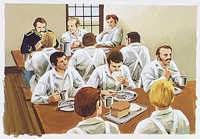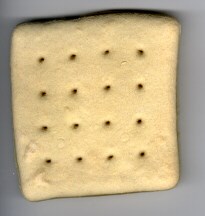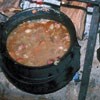
The exact daily rations for each man per day were as follows:
¾ pound of pork or 1¼ pounds of salt beef 18 oz. of flour-made into bread 2.4 oz. of beans or 1.6 oz of rice 1.6 oz. of coffee 1.92 oz. of sugar 5.1 oz. of vinegar 1¼ tablespoons salt
This was the food ration in the 1840s; although, the actual ration would have included soap and candles. The flour was made into bread and was baked on site in the post bakery or bake house. The rest of the rations would have been shipped and stored in the quartermaster storehouse. The salt beef or salt pork was usually not served as a meat dish but rather in a soup, a stew, or a hash, with the main difference between the three dishes being the amount of water poured into each one. Prior to this time, whiskey was also included as part of the standard army ration.
The rations were issued in bulk to the companies, cooked, and then served to the men. There were variations on these rations. For example, tea might be traded for coffee.
When on campaign, hardtack crackers were issued when fresh bread was not available, and hardtack was often issued in camp as well. One pound (about 9 or 10 crackers) was issued to the soldier whether on the march or in camp. Common problems with hardtack were being too hard, wet, moldy, or infested with maggots and weevils. One way to remedy these problems was to boil the hardtack in coffee and skim the weevils and maggots off the foam. Other culinary artists used hardtack to thicken their soup, toasted it with butter, soaked it in cold water and fried it in pork fat, it was called "skillygalee," or just ate it plain. Soldiers grumbled hardtack did not satisfy them. Many parodied the popular song "Hard Times." The following chorus illustrates their frustration: 
"Hard crackers, hard crackers, come again no more! Many days have you lingered upon our stomachs sore, O hard crackers, come again no more!" The ration in particular and the food in general was one of many factors that contributed to the soldiers' discontent with army life.
Despite promises to the contrary when they joined the army, soldiers often found army rations dull and unappetizing and complained about both the quality and quantity of the food. But at least the soldiers did not go hungry, unlike many civilians in the era. By the 1840s, the ration had actually improved because beans were added as were sugar and coffee. Bacon could replace the salt beef. Whiskey was out and vegetables were in; although, the vegetables were grown in the post gardens and weren't actually part of the ration. The information on hardtack comes from Hardtack and Coffee by John D. Billings, published by University of Nebraska Press (used by permission). |
Last updated: July 30, 2016

